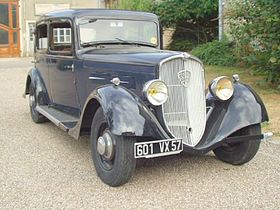Peugeot 601
| Peugeot 601 | |
|---|---|
 |
|
| Overview | |
| Manufacturer | S. A. des Automobiles Peugeot |
| Production | 1934 - 1935 3,999 produced |
| Body and chassis | |
| Body style | saloon limousine familiale cabriolet roadster coupe |
| Layout | FR layout |
| Powertrain | |
| Engine | 2,148 cc straight-6 60 hp at 3500 rpm |
| Dimensions | |
| Length | 4,600 mm (181.1 in)-5,080 mm (200.0 in) |
| Width | 1,600 mm (63.0 in) |
| Curb weight | 1,400 kg (3,100 lb) |
| Chronology | |
| Predecessor | Peugeot Type 183 |
| Successor | Peugeot 604 |
The Peugeot 601 was a range-topping car produced between 1934 and 1935 by Peugeot. It had its formal launch on 5 May 1934 and marked a return by the manufacturer to six-cylinder power units.
The car was equipped with a straight 6-cylinder 2148 cc engine developing 60 hp at 3500 rpm. With limited power and relatively high weight the car came with a listed top speed of only 105 kilometres per hour (65 mph) or 110 kilometres per hour (68 mph). The actual top speed will have varied according to the body fitted: the weight, including the car body, was given in 1934 as between 1,180 kg (2,600 lb) and 1,250 kg (2,760 lb) (or 1,400 kg (3,100 lb) for some long wheelbase versions).
A feature of the engine that attracted comment was the thermostatically controlled temperature regulator for the engine oil, which worked with an oil pump by redirecting the oil through, or away from, what was in effect a heat exchanger in a chamber filled with water from the radiator.
Like the other Peugeots of the era, the 601 was equipped with independent front suspension.
The 601 was closely based on the manufacturer's recently rebodied 201 and 301 models, but the longer six cylinder engine of the 601 enforced a longer wheelbase. As launched the 601 came with two different wheel base lengths, being 2,980 mm (117 in) for the 601 "Normale" and 3,200 mm (126 in) for the 601 "Longue".
There were three standard bodies offered for the "Normale" wheelbase cars: there was a four-door "Berline" (sedan/saloon) priced in Spring 1934 at 28,500 francs, a "Coach dėcapotable" with two doors, four seats and a cabriolet roof, priced at 34,000 francs of which only a hanful were sold, and a two-seater "Roadster" which became a frequent prize winner at "concours d'ėlėgance" enthusiasts' meetings.
Four standard bodies were listed for the "Longue" wheelbase cars. The least costly, listed at 31,000 francs, was a six-light "limousine familiale" with four doors and a deep bench seat combined with huge amounts of leg room in the back. There was also a "Berline aėrodynamique" with four doors and a streamlined body with a steeply raked tail and an overall length above 5,000 mm (197 in), as well as a "Coach Sport" with two doors and four seats which exploited the longer wheel-base to support a low streamlined look. From the summer of 1934 there was another long elegant two door four seater version listed, called the "Coach Profilė" .
There was in addition a special Eclipse body with electrical folding metal roof. The Eclipse was made by designer Georges Paulin, Emile Darl'mat and the coachbuilder Pourtout. This car gained renewed attention courtesy of the Peugeot publicity department in 1996 with the launch of the Mercedes-Benz SLK: the Mercedes featured a hinged steel roof that automatically folded into the boot/trunk at the press of a button which was briefly claimed as a world first, until Peugeot pointed out that the 601 Eclipse had used the same arrangement (albeit with more bulky mechanical components) sixty years earlier.
...
Wikipedia
